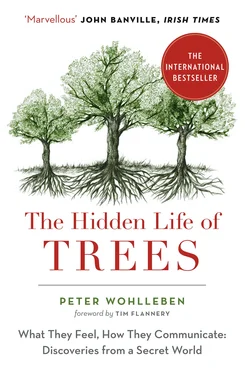I suspect fungi are a little more forward “thinking” than their larger partners. Among trees, each species fights other species. Let’s assume the beeches native to Central Europe could emerge victorious in most forests there. Would this really be an advantage? What would happen if a new pathogen came along that infected most of the beeches and killed them? In that case, wouldn’t it be more advantageous if there were a certain number of other species around—oaks, maples, ashes, or firs—that would continue to grow and provide the shade needed for a new generation of young beeches to sprout and grow up? Diversity provides security for ancient forests. Because fungi are also very dependent on stable conditions, they support other species underground and protect them from complete collapse to ensure that one species of tree doesn’t manage to dominate.
If things become dire for the fungi and their trees despite all this support, then the fungi can take radical action, as in the case of the pine and its partner Laccaria bicolor, or the bicolored deceiver. When there is a lack of nitrogen, the latter releases a deadly toxin into the soil, which causes minute organisms such as springtails to die and release the nitrogen tied up in their bodies, forcing them to become fertilizer for both the trees and the fungi. 28
I have introduced you to the most important tree helpers; however, there are many more. Consider the woodpeckers. I wouldn’t call them real helpers, but they are of at least some benefit to trees. When bark beetles infest spruce, for example, things get dicey. The tiny insects multiply so rapidly they can kill a tree very quickly by consuming its life-giving cambium layer. If a great spotted woodpecker gets wind of this, it’s on the spot right away. Like an oxpecker on a rhinoceros, it climbs up and down the trunk looking for the voracious, fat white larvae. It pecks these out (not thinking particularly of the tree), sending chunks of bark flying. Sometimes this can save the spruce from further damage. Even if the tree doesn’t come through this procedure alive, its fellow trees are still protected because now there won’t be any adult beetles hatching and flying around. The woodpecker is not in the slightest bit interested in the well-being of the tree, and you can see this particularly clearly in its nesting cavities. It often makes these in healthy trees, severely wounding them as it hacks away. Although the woodpecker frees many trees of pests—for instance, oaks from woodboring beetles—it is more a side effect of its behavior than its intent.
Woodboring beetles can be a threat to thirsty trees in dry years, because the trees are in no position to defend themselves from their attackers. Salvation can come in the form of the black-headed cardinal beetle. In its adult form, it is harmless, feeding on aphid honeydew and plant juices. Its offspring, however, need flesh, and they get this in the form of beetle larvae that live under the bark of deciduous trees. So some oaks have cardinal beetles to thank for their survival. And things can get dire for the beetles as well: once all the children of other species of beetles have been eaten, the larvae turn on their own kind.
10
— THE MYSTERIES OF —MOVING WATER
HOW DOES WATER make its way up from the soil into the tree’s leaves? For me, the way this question is answered sums up our current approach to what we know about the forest. For water transport is a relatively simple phenomenon to research—simpler at any rate than investigating whether trees feel pain or how they communicate with one another—and because it appears to be so uninteresting and obvious, university professors have been offering simplistic explanations for decades. This is one reason why I always have fun discussing this topic with students. Here are the accepted answers: capillary action and transpiration.
You can study capillary action every morning at breakfast. Capillary action is what makes the surface of your coffee stand a few fractions of an inch higher than the edge of your cup. Without this force, the surface of the liquid would be completely flat. The narrower the vessel, the higher the liquid can rise against gravity. And the vessels that transport water in deciduous trees are very narrow indeed: they measure barely 0.02 inches across. Conifers restrict the diameter of their vessels even more, to 0.0008 inches. Narrow vessels, however, are not enough to explain how water reaches the crown of trees that are more than 300 feet tall. In even the narrowest of vessels, there is only enough force to account for a rise of 3 feet at most. 29
Ah, but we have another candidate: transpiration. In the warmer part of the year, leaves and needles transpire by steadily breathing out water vapor. In the case of a mature beech, the tree exhales hundreds of gallons of water a day. This exhalation causes suction, which pulls a constant supply of water up through the transportation pathways in the tree. Suction works as long as the columns of water are continuous. Bonding forces cause the water molecules to adhere to each other, and because they are strung together like links in a chain, as soon as space becomes available in the leaf thanks to transpiration, the bonded molecules pull each other a little higher up the trunk.
And because even this is not enough, osmosis also comes into play. When the concentration of sugar in one cell is higher than in the neighboring cell, water flows through the cell walls into the more sugary solution until both cells contain the same percentage of water. And when that happens from cell to cell up into the crown, water makes its way up to the top of the tree.
Hmm. When you measure water pressure in trees, you find it is highest shortly before the leaves open up in the spring. At this time of year, water shoots up the trunk with such force that if you place a stethoscope against the tree, you can actually hear it. In the northeastern U.S. and Canada, people make use of this phenomenon to harvest syrup from sugar maples, which are often tapped just as the snow is melting. This is the only time of the year when the coveted sap can be harvested. This early in the year, there are no leaves on deciduous trees, which means there can be no transpiration. And capillary action can be only a partial contributor because the aforementioned rise of 3 feet is hardly worth mentioning. Yet at precisely this time, the trunk is full to bursting. So that leaves us with osmosis, but this seems equally unlikely to me. After all, osmosis works only in the roots and leaves, not in the trunk, which consists not of cells attached one to the other but of long, continuous tubes for transporting water.
So where does that leave us? We don’t know. But recent research has discovered something that at least calls into question the effects of transpiration and the forces of cohesion. Scientists from three institutions (the University of Bern; the Swiss Federal Institute for Forest, Snow, and Landscape Research; and the Swiss Federal Institute of Technology in Zurich) listened more closely—literally. They registered a soft murmur in the trees. Above all, at night. At this time of day, most of the water is stored in the trunk, as the crown takes a break from photosynthesis and hardly transpires at all. The trees pump themselves so full of water their trunks sometimes increase in diameter. The water is held almost completely immobile in the inner transportation tubes. Nothing flows. So where are the noises coming from? The researchers think they are coming from tiny bubbles of carbon dioxide in the narrow water-filled tubes. 30Bubbles in the pipes? That means the supposedly continuous column of water is interrupted thousands of times. And if that is the case, transpiration, cohesion, and capillary action contribute very little to water transport.
Читать дальше












